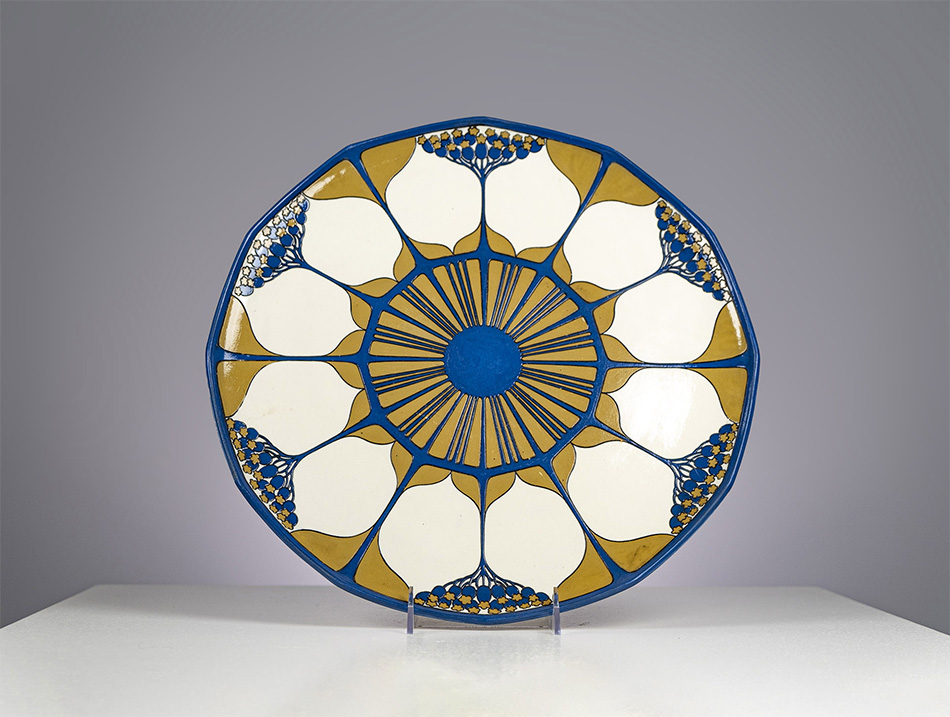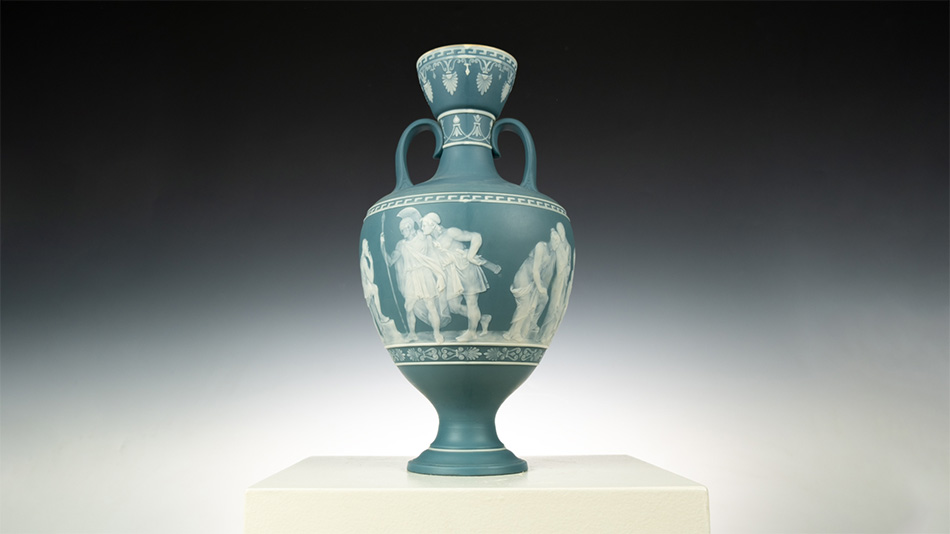


AMOCA’s Mettlach collection and exhibitions are made possible by Robert D. and Colette D. Wilson, who accumulated a remarkable number of Mettlach pieces over a 30-year period. AMOCA now houses their entire 3,000 plus piece Mettlach Collection, the largest and most comprehensive collection of Mettlach wares (dating from c.1840-1915) in the world. There are always several hundred pieces exhibited at the museum; the exhibition theme and works included change periodically.
The current exhibition, Artists of Mettlach, exhibits numerous examples of each of the known artists that designed wares for Mettlach.
By placing these vessels within the context of social history we are better able to understand their function and importance. The social history of Mettlach wares from past 200 years encompasses pleasure and pain, tradition and innovation, as well as extraordinary creativity in the decorative arts.
Pictured at top, from left-to-right (click on any of the images for a more detailed view):
- Villeroy & Boch, design by Heinrich Schlitt, Dwarf Eating Porridge in a Field of Mushrooms (2697), 1901. Etched ceramic. Gift of Bob and Colette Wilson. Photo Courtesy of AMOCA.
- Villeroy & Boch, design by Christian Warth, lidded tobacco jar (837), n.d. Parian porcelain, chromolith. Gift of Bob and Colette Wilson. Photo courtesy of AMOCA.
- Villeroy & Boch, 15 inch platter (2960), Art Nouveau dinnerware, 1910. Etched ceramic. Gift of Bob and Colette Wilson. Photo courtesy of AMOCA.
History
In 1836, a pottery company founded by François Boch and located in Mettlach, Germany, merged with another founded by Nicolas Villeroy to form the famous ceramic company called Villeroy & Boch (V&B). By the late 19th century V&B had seven factories, but the one at Mettlach, most famous and celebrated for its production of Chromolith (etched, incised) wares, became known by the name of the village: Mettlach. The Mettlach factory also produced wares using adapted techniques of high and low relief, PUG (printed under glaze), Phanolith, Cameo and hand-painted wares in the form of steins, plaques, vases, jardinières, table wares, and more. These wares were exhibited in the “Crystal Palace Exposition” in London in 1851 and in the “World Fairs” in Paris in 1878 and 1900 and Antwerp in 1885.
Mettlach wares were exported to the U.S. by the late 19th century, including items made specifically for the American market. Displayed at the World Fair exhibitions in Philadelphia (1876) and Chicago (1893), Mettlach ware became even more widely known. Further, many steins, including those made by Mettlach, found their way to the United States with soldiers returning from WWI and WWII. As a result of these circumstances, a significant portion of the existing Mettlach pieces are located and collected in the US today.
Scholarly Resources
Dr. Roy De Selms has published a series of articles on works in the collection, published in the periodical Prosit. The articles are reprinted here with the author’s permission:
- Part 1 – A Brief History of 19th Century Germany (September, 2019)
- Part 2 – German Culture Through the 19th Century (June, 2020)
- Part 3a – European Myths and Legends (December, 2020) – the page headings of “September 2020,” reprinted accurately here, are erroneous.
- Part 3b – Folklore, Fairy Tales and Fantasy (March, 2021)
- Part 4a – The Evolution of Relief, Cameo and Phanolith Wares (June, 2021)
- Part 4b – The Evolution of Chromolith, Etched/ Incised, Print Under Glaze (PUG), Rookwood/Faience/Delft Styles and Combination Wares (September, 2021)
- Part 5a – Mettlach at the AMOCA Museum: Mettlach Artists, Motifs, and Styles (March, 2022)
- Part 5b – Mettlach at the AMOCA Museum: Mettlach Artists, Motifs, and Styles (June, 2022)
- Part 5c – Mettlach at the AMOCA Museum: Mettlach Artists, Motifs, and Styles (September, 2022)
Separately, Dr. De Selms also published an article in the September, 2013 issue of Prosit on the collection itself.
Exhibitions
Since the remarkable gift by Robert D. and Colette D. Wilson in 2011, a number of exhibitions have been mounted primarily from this collection:
Selections from the Collection
 Villeroy & Boch Mettlach. Jardiniere (#1128), 1885. Etched and glazed relief in fine stoneware. 16 x 23 x 10 inches. Photo courtesy of AMOCA.
Villeroy & Boch Mettlach. Jardiniere (#1128), 1885. Etched and glazed relief in fine stoneware. 16 x 23 x 10 inches. Photo courtesy of AMOCA.This jardiniere is one of the many works donated by Bob and Colette Wilson. Mettlach (named after the village) is one of the factories of Villeroy & Boch located on the Saar River in western Germany, very close to the borders of France and Luxembourg. The factory was housed on the grounds of a former Benedictine Abbey dating to the 10th Century. The Abbey tower became a symbol for the quality and design of the Mettlach factory. On this side of the jardiniere the Abbey can be seen in the landscape. The factory ceased manufacture of these works during WWI and in August 1921 after a great fire destroyed the pattern and mold storehouse, but some molds survived and were used again in the late 1920’s.
 Villeroy & Boch Mettlach. Relief Plaque (#1696), ca. 1892. 16.5 inch diameter. Photo courtesy of AMOCA.
Villeroy & Boch Mettlach. Relief Plaque (#1696), ca. 1892. 16.5 inch diameter. Photo courtesy of AMOCA.This Mettlach plaque was made using a variety of different techniques. The relief angel was hand applied requiring great skill and attention to detail by the sculptor. Gilding with gold on the edges and highlights required an extra low firing step. The angel (Greek Angelos = messenger) in this case is a womanly angel with a message of peace in the spring of life as symbolized by what appears to be laurel branches with blooms.
 Villeroy & Boch Mettlach, Phanolith Vase (#7010), c.1899. 13 inches tall. Photo courtesy of AMOCA.
Villeroy & Boch Mettlach, Phanolith Vase (#7010), c.1899. 13 inches tall. Photo courtesy of AMOCA.This Phanolith, 2-handled vase has scenes from the Trojan War. Mettlach Phanolith items were translucent and made of soft-paste porcelain in the technique developed at Mettlach by Jean Baptiste Stahl. This technique is similar to that of the earlier Wedgwood wares from England.